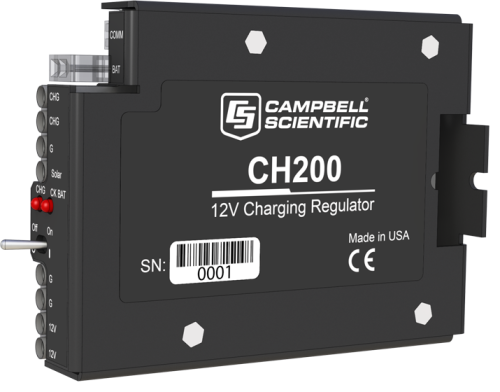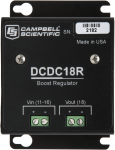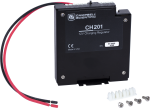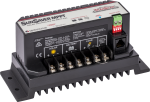
Manages voltage and amperage to protect battery






Overview
The CH200 is microcontroller-based smart charge controller that is ideal for an external rechargeable 12 Vdc VRLA battery such as Campbell Scientific's BP12 or BP24. The controller manages amperage and voltage for safe, optimized battery charging from a solar-panel or ac power source. It also measures various input, output, and status parameters to allow close monitoring of the battery.
This featured product was part of the Aconcagua expedition to install a weather station on South America’s tallest peak. Learn more about the expedition on our Extreme Application Series: Aconcagua page.
Read MoreBenefits and Features
- Two-step constant voltage charging and temperature compensation optimize battery charging and increase the battery’s life
- Allows charging from various sources: solar panels or AC wall chargers
- Allows simultaneous connection of two charging sources (e.g., solar panel, ac wall charger)
- Ability to monitor both load and battery current
- Real-time measurements of charge input voltage, battery voltage, on-board temperature, battery current, and load current
- Protects against high-amperage and high-voltage damage to power supply
- Battery reversal protection
Images














3D/CAD Files:
Detailed Description
The CH200 has two input terminals that enable simultaneous connection of two charging sources. It also incorporates a maximum power point tracking algorithm for solar inputs that maximize available solar charging resources. RS-232 and SDI-12 terminals allow the CH200 to convey charging parameters to a datalogger.
The CH200 has several safety features intended to protect the charging source, battery, charger, and load devices. Both the SOLAR – G and CHARGE – CHARGE input terminals incorporate hardware current limits and polarity reversal protection.
A fail-safe, self-resettable thermal fuse protects the CHARGE – CHARGE inputs in the event of a catastrophic AC/AC or AC/DC charging source failure. Another self-resettable thermal fuse protects the 12 V output terminals of the charger in the event of an output load fault.
The CH200 also has battery reversal protection, and includes ESD and surge protection on all of its inputs and outputs.
Compatibility
Please note: The following shows notable compatibility information. It is not a comprehensive list of all compatible products.
Additional Compatibility Information
Batteries
This charging regulator can charge the following battery families: EnerSys Genesis NP Series (includes our PS200, BP12, and BP24), EnerSys Cyclone Series, Concorde Sun Xtender Series (includes our BP84) and a custom battery.
Specifications
| Operational Temperature | -40° to +60°C (VRLA battery manufacturers state that “heat kills batteries” and recommend operating batteries at ≤ 50°C.) |
| Dimensions | 7.5 x 3.7 x 10 cm (3 x 1.5 x 3.9 in.) |
CHARGE - CHARGE Terminals (AC or DC Source) |
|
| AC | 18 to 24 VRMS (with 1.2 ARMS maximum) |
| DC | 16 to 40 Vdc (with 1.1 Adc maximum) |
SOLAR Terminals (Solar Panel or Other DC Source) |
|
| -NOTE- | Battery voltages below 8.7 V may result in less than 3.0 A current limit because of fold-back current limit. |
| Input Voltage Range | 15 to 40 Vdc |
| Maximum Charging Current | 4.0 Adc typical (3.2 to 4.9 Adc depending upon individual charger) |
Quiescent Current |
|
| No Charge Source Present | 300 μA maximum |
| No Battery Connected | 2 mA maximum |
Battery Charging |
|
| -NOTE- | Two-step temperature-compensated constant-voltage charging for valve-regulated lead-acid batteries; cycle and float charging voltage parameters are programmable with the default values listed. |
| CYCLE Charging | Vbatt(T) = 14.70 V - (24 mV) x (T-25°C) |
| FLOAT Charging | Vbatt(T) = 13.65 V - (18 mV) x (T-25°C) |
| Accuracy | ±1% (on charging voltage over -40° to +60°C) |
Power Out (+12 Terminals) |
|
| Voltage | Unregulated 12 V from battery |
| 4 A Self-Resettable Thermal Fuse Hold Current Limit |
|
Measurements |
|
| -NOTE- | At -40° to +60°C |
| Average Battery Voltage | ±(1% of reading + 15 mV) |
| Average Battery/Load Current Regulator Input Voltage |
±(2% of reading + 2 mA) Impulse type changes in current may have an average current error of ±(10% of reading + 2 mA). |
| Solar |
±(1% of reading - 0.25 V) / -(1% of reading + 1 V) 1.0 V negative offset is worst-case due to reversal protection diode on input; typical diode drop is 0.35 V. |
| Continuous |
±(1% of reading - 0.5 V) / -(1% of reading + 2 V) 2.0 V negative offset is worst-case due to two series diodes in AC full-bridge. Typical diode drops are 0.35 each for 0.7 V total. |
| Charger Temperature | ± 2°C |
Documents
Product Brochures
Downloads
CH200 / PS200 OS v.11 (434 KB) 24-04-2020
Execution of this download installs the CH200 / PS200 Operating System on your computer.
Note: The Device Configuration Utility is used to upload the included operating system to the CH200 / PS200.
Frequently Asked Questions
Number of FAQs related to CH200: 1
-
The CH200 or PS200 will pull power only from the source with the highest voltage at that moment. For example, the regulator will take the 20 W input from the 24 Vdc wall transformer rather than from the 18 V 50 W solar panel—even during the day. If the power goes out, the 50 W solar panel will charge during the day with no charging at night.
Casos de estudio
Overview Iraq’s Ministry of Agriculture has deployed a nationwide network of solar-powered, satellite-linked agrometeorological stations. The......read more




